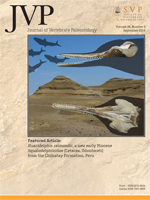Associated fragments of a maxilla and mandible of Theosodon hystatus Cabrera and Kraglievich (Macraucheniidae, Litopterna) from the late Miocene Arroyo Chasicó locality (Buenos Aires Province, Argentina) are described and taxonomically reinterpreted. The systematic arrangement is supported by the first phylogenetic analysis of the family. The holotype (MLP 29-IX-1-75) of T. hystatus was originally poorly described and its generic assignation was not fully justified. The comparison of MLP 29-IX-1-75 with Paranauchenia denticulata Ameghino from the ‘Mesopotamiense’ (lower member of the Ituzaingó Formation, Entre Ríos Province; late Miocene) shows significant morphological similarities that lead us to propose that T. hystatus belongs to the genus Paranauchenia Ameghino, resulting in the new combination Paranauchenia hystata. The phylogenetic analysis of Macraucheniidae supports this proposal because both taxa form a monophyletic clade, sharing one synapomorphy: metaconid of m2 lingually placed. This new taxonomic interpretation implies the geographic extension of Paranauchenia to Buenos Aires Province. The obtained phylogeny also corroborates the monophyly of Macraucheniidae, but not that of the currently considered subfamilies, because Cramaucheniinae is paraphyetic.
How to translate text using browser tools
1 September 2014
Taxonomic Reinterpretation of Theosodon hystatus Cabrera and Kraglievich, 1931 (Litopterna, Macraucheniidae) and Phylogenetic Relationships of the Family
Gabriela I. Schmidt,
Brenda S. Ferrero
ACCESS THE FULL ARTICLE





